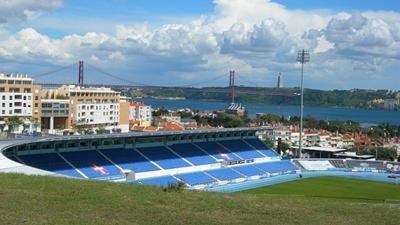 The focus today falls on Belenenses in the third of PortuGOAL’s series of in-depth analyses of Portugal’s lesser known top-flight clubs.
The focus today falls on Belenenses in the third of PortuGOAL’s series of in-depth analyses of Portugal’s lesser known top-flight clubs.
At a club steeped in history, new coach Quim Machado is starting to get the best out of an extremely talented squad, which includes players that could well have a huge future in the game.
Tiago Estêvão runs the rule over Machado’s team, who recently took points off FC Porto and will be aiming to deepen Sporting’s crisis at the Restelo tonight.
Historical, classical, noteworthy, respected perhaps – these are all words most Portuguese football fans will connect with Clube de Futebol Os Belenenses. If you came by Lisbon as a tourist, you probably know them as the club whose blue stadium you saw from the sky as your plane turned to approach the airport. It is also very near the spot where visitors – and local residents – like to treat themselves to the famous and delicious Pastéis de Nata. And while I would say “fair enough” to that, there’s a lot more to this club than just being located in what of the Portuguese capital’s more iconic spots.
Belenenses used to be one of the biggest teams in the country, with a ton of Portuguese internationals and even winning the league in 1945/46 – something only them and Boavista have managed outside the big 3 – but as is the case for so many other “sleeping giants” of European football, the modern days haven’t been so kind to them. In this century, they have largely been a mid-table side, with two seasons good enough to take them into Europe but also with a 3-year stint in the second division.
Managerial graveyard
The team has now been in the first division for three years straight and while the results have been solid – 14th, 6th and 9th – there hasn’t been enough stability when it comes to managers. To be quite honest, it’s a strange case that Belenenses’ results haven’t been tremendously affected by the seven managerial changes in these three years. But most would agree that when it comes to looking to the future and developing this club to achieve the remarkable glories of the past, it’s important to trust a leader with a project. I believe Quim Machado, who was hired half-way through this season, may just be the man for the job.
Although the cold stats do not show it, due to the team’s lack of goals – only 10 scored in the league – the side tries to play possession football as much possible, trying to dominate the game, especially against teams of similar calibre. Even when facing bigger opponents, despite playing with more men inside their own half for obvious reasons, the team has not held back from pushing bodies forward and trying to score – neither did they try to resort to time-wasting or any other approach that is frowned upon. At the moment they sit 8th, only behind the eternal European candidates and the surprising Chaves.
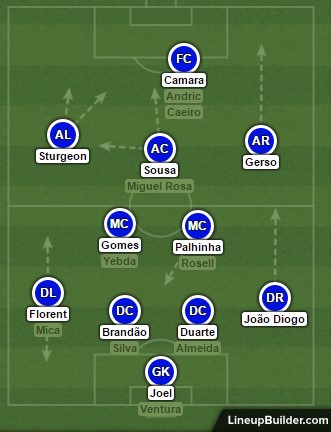 Future Manchester United goalkeeper?
Future Manchester United goalkeeper?
Clever enough to take advantage of the basis left by Spanish coach Julio Velazquez who left the job early October, Machado has got the team playing attractive football without disregarding the defensive side of his game. One of the first changes the new manager made was to include young goalkeeper Joel Pereira in his starting eleven. On loan from Manchester United, the 20-year old was behind Ventura in the pecking order but Machado turned that around with pretty satisfactory results. The young shot-stopper is exactly that, a brilliant player between the sticks whose rapid reflexes have very often been evident, especially against the top sides.
Somewhat naïve when it comes to his timing to come off his line and in control of his back four, this experience in the first division is already helping him improve and it’ll be interesting to see what Mourinho has planned for him in Manchester.
Ahead of Joel Pereira, Machado didn’t switch much of the backline that has been playing since the start. Perhaps the team’s most consistent performer, Florent Hanin, arrived this summer to play the most minutes out of anyone in the team. The French left-back played for Leixões and Moreirense in Portugal before travelling around Europe in the past few years. With an average of two tackles, interceptions and clearances per game, the ex-St Gallen full-back clearly prioritizes the defensive process.
On the right, the versatile João Diogo arrived in summer from Marítimo and, despite having started a couple of times higher up the pitch, he is the usual starting right-back who pushes forward more often and gets more involved with the attackers. Not only does he tend to have less defensive actions in the game, he gets fouled more often and tends to have more crosses and assists which shows greater offensive participation.
Rock solid Duarte
In the heart of the backline, Domingos Duarte has been the constant. On loan from Sporting, the 21-year-old stands over 190 cm tall making him a massive presence in the backline who has scored once this season. Always fully focused and with excellent interception timing, he still needs to work on how often he gets booked and how often he fouls opponents in general. While most people assumed he’d have minutes here, the amount of responsibility he has been given in the backline has been tremendous considering the numerous partnerships he has had to forge with Gonçalo Silva and Dinis Almeida, after captain Brandão got injured in early November.
Duarte didn’t seem fazed by that and even when starting off attacks he has shown quality in playing long balls as well. While he doesn’t appear a world-beater, I’m sure Sporting will have some interesting plans for him in the future.
In a 4-2-3-1 on paper, the team doesn’t assume that form as often as expected on the pitch. Defensively the more attacking out of the three midfielders, Andre Sousa, joins striker Camara in more of a 4-4-2 with close lines, while during the offensive build-up Vitor Gomes moves slightly higher so Machado’s men construct play with a 1-2 midfield, instead of the other way around.
Talking tactics
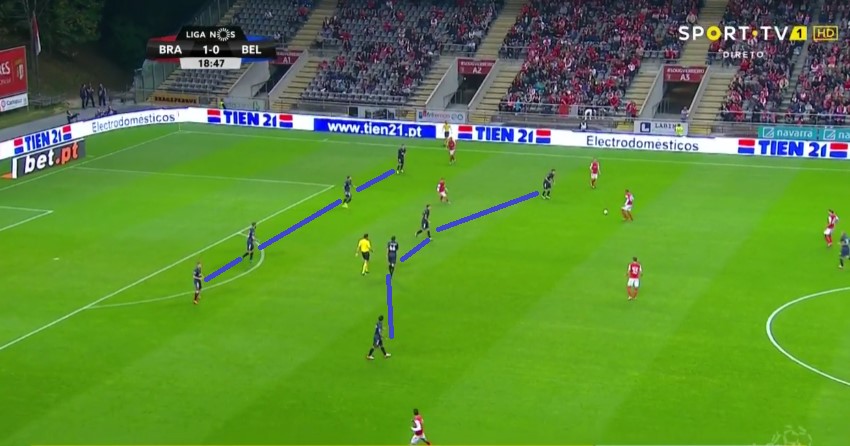
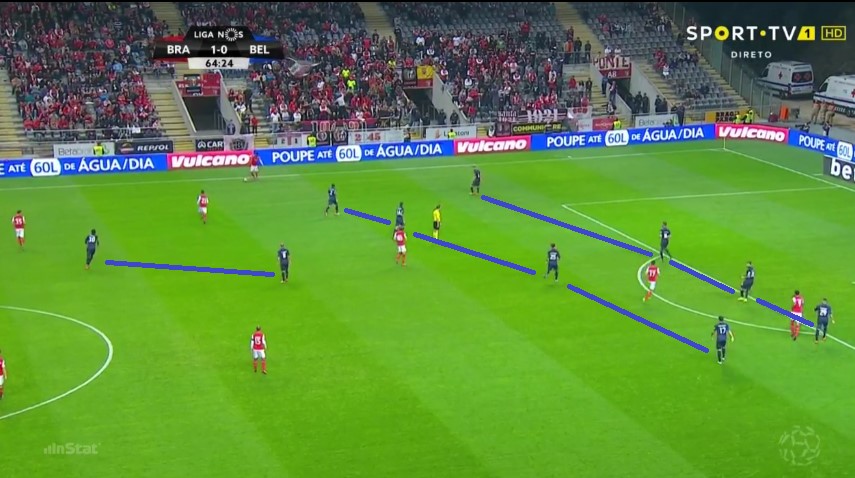
D1, D2 – Usually defending in two close banks of four, Sousa joins Camara in the most advanced line. When the team is pushed back into their own half, Sousa tends to join Gomes and Palhinha.
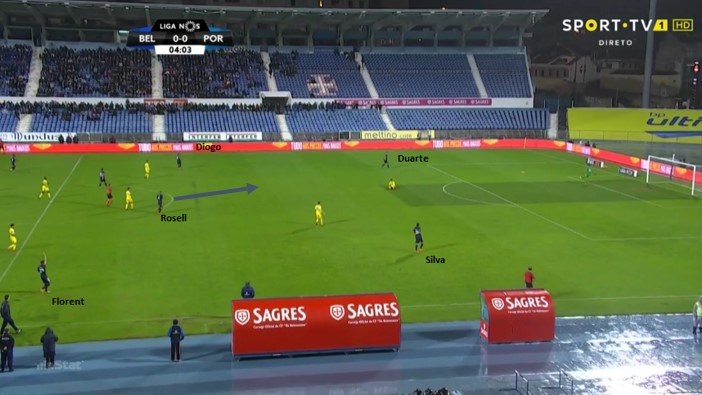
O1 – Here we watch their initial build up against Porto. Both full-backs give the team width further forward and the CBs staying open gives goalkeeper Joel two options. The DM, in this case Rosell, who replaced Palhinha, proceeds to drop in support.
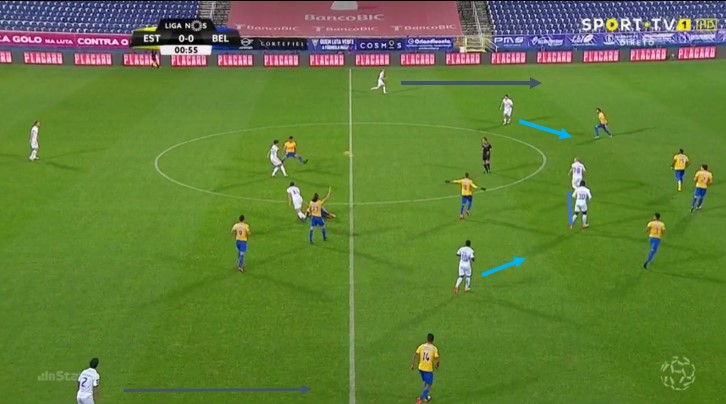
O2 – With the ball in midfield already, both full backs push up to take over the wings and give the team width while the wingers – especially Sturgeon – drift inside. Here seen very close to Camara, Sousa tends to cover open spaces, whether that’s giving wing support or staying on the edge of the box.
Profile of a world star in the making
Anchoring this midfield and the entire team is João Palhinha – one of the world’s top young defensive midfielders. There’s a reason why Sporting wants him back from loan in January. The Lions need someone to cover for William Carvalho and I believe that in the not too distant future, Palhinha will reach at least the same level of performance as the Portugal international.
Let’s start from the physical perspective: as per usual with defensive midfielders, Palhinha isn’t the quickest but in the air almost literally nothing goes past him – with 3.9 aerials won per match, no-one in the league has more – and standing 189 cm tall, the youngster is always a target on set pieces having scored from a corner v Vitória SC. Usually dropping between his centre-backs to start off the build-up via long and short passes, it’s actually when it comes to recovering possession that he excels: his three successful tackles per match from only 3.2 attempted per match puts him close to the league’s top 10 to exemplify this point.
Palhinha gets dribbled past about once every five matches – or 0.2 times per match if you will. To put this into perspective, William Carvalho is dribbled past around once a game (five times more often than Palhinha) and Fejsa over 2 times a game (ten times more often than him), so it is a remarkable statistic.
But not everything is positive: João leads the league in yellows with 7 and is close to the top ten in fouls per match. While you often need to break up play as a DM, you also need to realise these numbers are way too high and need to be controlled, via the improvement in his timing and football IQ, also known as experience which he is getting week in and week out.
Gomes boost
Vitor Gomes’s arrival was a major boost to the team as well: the experienced midfielder arrived after the start of the season and gave a different dimension to a midfield that was previously perhaps too defensive-minded with Uri Rosell alongside Palhinha. Gomes’s experience and quality on the ball helped the team gain more control through the centre and added impact launching a large proportion of the team’s offensive transitions.
Ahead of him Andre Sousa has been another reliable asset. While not the most technically gifted attacking midfielder, the 26-year-old’s work rate is immense and not only is he important via the defensive pressure from a high position that he offers but also due to how often he creates danger from both outside and inside the box. Drifting to wide positions with ease, he allows his wingers to move inside and create chances. His 1.5 key passes per game are on par with the numbers from the likes of Gelson Martins, Bryan Ruiz or Salvio.
Gerso and Sturgeon have been the chosen duo on the wings. The Sporting KC-bound winger is known for his blistering pace but his remarkable stamina often goes unnoticed – I’ve seen the Guinean pull outstanding runs even after 90’ of play. Leading the club’s assist board, he is more of a classic winger in comparison to Fabio Sturgeon. The 22-year-old Sturgeon, who was in the Portuguese Olympic squad, took a bit of time to get going but is now having one of his most consistent seasons to date. Able to play on both wings and even behind the striker, he’s the main creative source for Belenenses’s front line. He leads the team in dribbles, has over one key pass per match and apart from the striker Camara, no-one in the team shoots more often than him. Braga’s reported interest is, therefore, all but unexpected.
Miguel Rosa was injured for a good chunk of time and has been played mostly off the bench since returning. He is not as quick as he once was, but the Benfica academy product’s technique is still sublime and he is able to keep the ball like few others, especially when playing through the centre, although he doesn’t offer the pressure Andre Sousa does so he ends up somewhat situational.
Tireless worker, but...
Up front, top scorer Camara leads the line. Another tireless worker, Camara has been shooting blanks for most of the season: the Guinean has scored three times so far but is 7th in the league in terms of shots per match with over 2.5 and a total of over 30 in the league. Much like Andre Sousa, Camara’s defensive contribution is remarkable and his freedom of movement can be beneficial at times but I’m afraid the Belem side will be looking for a little bit more assertive firepower in the front man. The two other options of Andric and Tiago Caeiro are perhaps a bit too static for the style Machado wants to implement and I wouldn’t be surprised to see the team looking for January additions in this position.
Fourteen matches into the league, we can now compare the team under the two different coaches since Belenenses played 7 matches under each one. Under Machado Belenenses conceded only six times in the league compared to eight under Velazquez and while one could argue the difference isn’t major, it is an impressive statistic when you consider that under the new manager the team played Benfica, Porto and Braga. So the defensive process has clearly been a priority and has undergone major improvement, despite the team being one of the most aggressive ones in the league (40 total cards) which can be polished, but goals are lacking on the other end.
Powder puff attack
The issue goes way beyond Camara’s lack of effectiveness mentioned before. It is a shared problem among everyone in the squad. At the time of writing, Belenenses has the worse attack in the league with only 10 goals scored, but has more shots per game (11.6) than a team like Vitória Guimarães. But not only are chances being created, most of these shots are coming from inside the box so everything just screams for the need of a good finisher up top. The team created more chances than the opposition and controlled the majority of the game in their last three fixtures – Estoril, Marítimo, Paços – and at the end only grabbed 4 points from them due to a lack of effectiveness up top.
Finally, as we head out to January we must finish up with the team’s approach to the market. With Gerso certain to move to the MLS, winger Mengolo (who at 23 has already played twice for the Cameroonian NT) has arrived already from Levski Sofia and while I have mentioned the necessity to look for a centre-forward, there’s another thing lacking. Domingos Duarte and Palhinha have been key for the team and they’re rumoured to be heading back to their parent club soon. I believe that there aren’t proper replacements at the club and Belenenses could be in real trouble if that isn’t properly assessed.
Right before Christmas, the Blues from Restelo host Sporting (tonight) and will not only be without of the aforementioned duo (loan players are now forbidden from playing against their parent club in Portugal) but also of a player like Rosell who could be an option for midfield as he was when Palhinha was out vs. Porto. Ex-Benfica midfielder Hassan Yebda should be the chosen option to face Sporting but I’m sure January will be full of action for the team besides the Rio Tejo.
To finish up, it’s worth mentioning that Belenenses has one of the most Portuguese squads in the league with only 5 foreign players – plus Gerso and Camara who’ve got dual nationality. Nowadays, that’s something worthy of our support and it just fits so well that the club based at one of the most iconic, representative parts of Portugal, has a big majority of Portuguese players.
by Tiago Estêvão
Related: In-depth team analysis: Nacional da Madeira
Related: In-depth team analysis: Vitória de Guimarães

